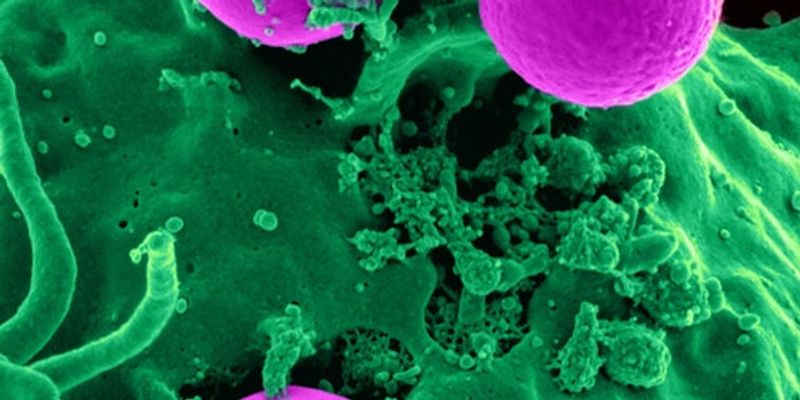Cell
Cell: is the smallest structural and functional unit of an organism, typically microscopic and consisting of cytoplasm and a nucleus enclosed in a membrane. Microscopic organisms typically consist of a single cell, which is either eukaryotic or prokaryotic.
-
Molecular chaperones help nascent polypeptides fold correctly and multimeric protein complexes assemble productively, while minimizing the danger of aggregation in the protein-rich intracellu...Speaker: Len Neckers, PhD
OCT 17, 2013 | 2:00 PM
C.E. CREDITS
Pancreatic cancer is the 4th most common cause of cancer deaths in the United States. Due to the aggressive nature of this cancer and the lack of biomarkers for early detection, the incidence...
Speaker:
Antonio T. Baines, PhD
OCT 17, 2013 | 1:00 PM
C.E. CREDITS
Invading cancer cells leave the tumor to form distant metastases and are ultimately responsible for 90% of deaths in cancer. Reducing the ability of cancer cells to invade and metastasize cou...
Speaker:
Milan Radovich, PhD
OCT 17, 2013 | 12:00 PM
The discovery of proteinaceous disease biomarkers and their clinical validation is critically important for the enablement of molecular diagnostics and ultimately, precision medicine. In spit...
Speaker:
Martin Latterich, PhD
OCT 17, 2013 | 12:00 PM
C.E. CREDITS
Invading cancer cells leave the tumor to form distant metastases and are ultimately responsible for 90% of deaths in cancer. Reducing the ability of cancer cells to invade and metastasize cou...
Speaker:
Daniel Irimia, MD, PhD
OCT 17, 2013 | 11:00 AM
C.E. CREDITS
Curative therapy for metastatic disease in solid malignancies remains frustratingly elusive due to the long recognized problem of tumor cell heterogeneity and emergence of treatment resistant...
Speaker:
George Poste, DVM, DSc, PhD
OCT 17, 2013 | 10:00 AM
C.E. CREDITS
Prostate cancer epithelial cells depend on androgens for their survival. Because of this dependence, androgen deprivation therapy is the major treatment of advanced prostate cancer. Such ther...
Speaker:
Donald Tindall, PhD
OCT 17, 2013 | 9:00 AM
C.E. CREDITS
Cancer metastases develop when tumor cells known as circulating tumor cells (CTCs) are shed from a tumor, circulate through the blood stream and colonize a distant tissue. The number of CTCs...
Speaker:
Lori M. Millner, PhD
OCT 17, 2013 | 8:00 AM
C.E. CREDITS
Developments in DNA sequencing technology have provided a unique opportunity for diagnosis and discovery of genetic alterations for rare diseases. Partnering with 20 academic centers in the U...
Speaker:
C Jimmy Lin, MD, PhD, MHS
OCT 17, 2013 | 7:00 AM
Whenever there is cell death, apoptotic cell free DNA fragments appear in the circulation of the host. These fragments, typically 145-160 base pairs in size, represent a minute fraction of to...
Speaker:
Charles Cantor, PhD
OCT 17, 2013 | 6:00 AM
The widespread adoption of precision medicine in oncology requires: a compendium of therapies targeting the genetic vulnerabilities of cancer; the diagnostic tools capable of generating a pr...
Speaker:
Dan Rhodes, PhD
OCT 16, 2013 | 3:00 PM
C.E. CREDITS
Deregulation of ACK1, a non-receptor tyrosine kinase originally identified by its ability to bind to GTP-bound Cdc42 (hence the name: activated Cdc42-associated kinase)(Manser et al., 1993),...
Speaker:
Henry Chang, PhD
OCT 16, 2013 | 2:00 PM
C.E. CREDITS
Non Small Cell Lung Cancer (NSCLC) is one of the most significant causes of cancer-related mortality worldwide. In about 6-7% of NSCLC, rearrangements involving the Anaplastic Lymphoma Kinase...
Speaker:
Roberto Chiarle, MD
OCT 16, 2013 | 1:00 PM
C.E. CREDITS
Cancer cells have historically been classified by microscopic analysis of blood smears and tissue sections. Current technologies use molecular techniques to categorize and classify tumor cell...
Speaker:
Kristin Landis-Piwowar, PhD, MLS
OCT 16, 2013 | 1:00 PM
C.E. CREDITS
The remarkable diversity we see between different cell types in the human body is governed by the specificity attained through transcriptional and epigenetic regulatory programs. Cancer is a...
Speaker:
Jessica C. Mar, PhD
OCT 16, 2013 | 12:00 PM
C.E. CREDITS
The eukaryotic translation initiation factor eIF4E is a potent oncogene estimated to be elevated in about 30% of human cancers including cancers of the breast, prostate, lung, colon as well a...
Speaker:
Katherine LB Borden, PhD
OCT 16, 2013 | 11:00 AM
Survival rates for early stage non-small cell lung cancer (NSCLC) remain unacceptably low compared to other common solid tumors. This mortality reflects a weakness in conventional staging, a...
Speaker:
Michael J Mann, MD
OCT 16, 2013 | 11:00 AM
"SuperSelective" primers, by virtue of their unique design, enable only a few molecules of a mutant sequence to generate amplicons in conventional, real-time PCR assays without interference...
Speaker:
Fred Kramer, PhD
OCT 16, 2013 | 7:00 AM
C.E. CREDITS
With the rapid rise in the number of therapeutic options for men with castration-resistant prostate cancer (CRPC) comes increasingly complicated treatment decision-making, emphasizing the nee...
Speaker:
Andrew Armstrong, MD ScM FACP
Cancer cells are characterized by major alterations in both cellular metabolism and epigenetic profiles. Current understanding of links between metabolism and chromatin in the context of can...
Speaker:
Kathryn E Wellen, PhD
The adjuvant therapy of choice for superficial bladder cancer is the intravesical instillation of live Mycobacterium bovis Bacillus Calmette-Guerin (BCG). In spite of the fact that this thera...
Speaker:
R. Claudio Aguilar, PhD
OCT 16, 2013 | 6:00 AM
The knowledge of molecular alterations involved in colon carcinoma (CRC) and non-small-cell lung carcinoma (NSCLC) has significantly increased in the past few years. Molecular subgroups of t...
Speaker:
Nicola Normanno, MD
AUG 22, 2013 | 5:00 PM
C.E. CREDITS
Malignancies caused by so-called Type I chemical and biological carcinogens provide important opportunities studying early events in cancer development, providing essential information for de...
Speaker:
Prof. Patrick Tan, MD, PhD
Presented at: Genetics and Genomics Virtual Event Series 2013
As Chief of Scientific Intelligence at the John Wayne Cancer Institute, Dr. Hoon interacts with external academic, industry, and government agencies to develop innovative translational rese...
Molecular chaperones help nascent polypeptides fold correctly and multimeric protein complexes assemble productively, while minimizing the danger of aggregation in the protein-rich intracellu...
Speaker:
Len Neckers, PhD
OCT 17, 2013 | 2:00 PM
C.E. CREDITS
Pancreatic cancer is the 4th most common cause of cancer deaths in the United States. Due to the aggressive nature of this cancer and the lack of biomarkers for early detection, the incidence...
Speaker:
Antonio T. Baines, PhD
OCT 17, 2013 | 1:00 PM
C.E. CREDITS
Invading cancer cells leave the tumor to form distant metastases and are ultimately responsible for 90% of deaths in cancer. Reducing the ability of cancer cells to invade and metastasize cou...
Speaker:
Milan Radovich, PhD
OCT 17, 2013 | 12:00 PM
The discovery of proteinaceous disease biomarkers and their clinical validation is critically important for the enablement of molecular diagnostics and ultimately, precision medicine. In spit...
Speaker:
Martin Latterich, PhD
OCT 17, 2013 | 12:00 PM
C.E. CREDITS
Invading cancer cells leave the tumor to form distant metastases and are ultimately responsible for 90% of deaths in cancer. Reducing the ability of cancer cells to invade and metastasize cou...
Speaker:
Daniel Irimia, MD, PhD
OCT 17, 2013 | 11:00 AM
C.E. CREDITS
Curative therapy for metastatic disease in solid malignancies remains frustratingly elusive due to the long recognized problem of tumor cell heterogeneity and emergence of treatment resistant...
Speaker:
George Poste, DVM, DSc, PhD
OCT 17, 2013 | 10:00 AM
C.E. CREDITS
Prostate cancer epithelial cells depend on androgens for their survival. Because of this dependence, androgen deprivation therapy is the major treatment of advanced prostate cancer. Such ther...
Speaker:
Donald Tindall, PhD
OCT 17, 2013 | 9:00 AM
C.E. CREDITS
Cancer metastases develop when tumor cells known as circulating tumor cells (CTCs) are shed from a tumor, circulate through the blood stream and colonize a distant tissue. The number of CTCs...
Speaker:
Lori M. Millner, PhD
OCT 17, 2013 | 8:00 AM
C.E. CREDITS
Developments in DNA sequencing technology have provided a unique opportunity for diagnosis and discovery of genetic alterations for rare diseases. Partnering with 20 academic centers in the U...
Speaker:
C Jimmy Lin, MD, PhD, MHS
OCT 17, 2013 | 7:00 AM
Whenever there is cell death, apoptotic cell free DNA fragments appear in the circulation of the host. These fragments, typically 145-160 base pairs in size, represent a minute fraction of to...
Speaker:
Charles Cantor, PhD
OCT 17, 2013 | 6:00 AM
The widespread adoption of precision medicine in oncology requires: a compendium of therapies targeting the genetic vulnerabilities of cancer; the diagnostic tools capable of generating a pr...
Speaker:
Dan Rhodes, PhD
OCT 16, 2013 | 3:00 PM
C.E. CREDITS
Deregulation of ACK1, a non-receptor tyrosine kinase originally identified by its ability to bind to GTP-bound Cdc42 (hence the name: activated Cdc42-associated kinase)(Manser et al., 1993),...
Speaker:
Henry Chang, PhD
OCT 16, 2013 | 2:00 PM
C.E. CREDITS
Non Small Cell Lung Cancer (NSCLC) is one of the most significant causes of cancer-related mortality worldwide. In about 6-7% of NSCLC, rearrangements involving the Anaplastic Lymphoma Kinase...
Speaker:
Roberto Chiarle, MD
OCT 16, 2013 | 1:00 PM
C.E. CREDITS
Cancer cells have historically been classified by microscopic analysis of blood smears and tissue sections. Current technologies use molecular techniques to categorize and classify tumor cell...
Speaker:
Kristin Landis-Piwowar, PhD, MLS
OCT 16, 2013 | 1:00 PM
C.E. CREDITS
The remarkable diversity we see between different cell types in the human body is governed by the specificity attained through transcriptional and epigenetic regulatory programs. Cancer is a...
Speaker:
Jessica C. Mar, PhD
OCT 16, 2013 | 12:00 PM
C.E. CREDITS
The eukaryotic translation initiation factor eIF4E is a potent oncogene estimated to be elevated in about 30% of human cancers including cancers of the breast, prostate, lung, colon as well a...
Speaker:
Katherine LB Borden, PhD
OCT 16, 2013 | 11:00 AM
Survival rates for early stage non-small cell lung cancer (NSCLC) remain unacceptably low compared to other common solid tumors. This mortality reflects a weakness in conventional staging, a...
Speaker:
Michael J Mann, MD
OCT 16, 2013 | 11:00 AM
"SuperSelective" primers, by virtue of their unique design, enable only a few molecules of a mutant sequence to generate amplicons in conventional, real-time PCR assays without interference...
Speaker:
Fred Kramer, PhD
OCT 16, 2013 | 7:00 AM
C.E. CREDITS
With the rapid rise in the number of therapeutic options for men with castration-resistant prostate cancer (CRPC) comes increasingly complicated treatment decision-making, emphasizing the nee...
Speaker:
Andrew Armstrong, MD ScM FACP
Cancer cells are characterized by major alterations in both cellular metabolism and epigenetic profiles. Current understanding of links between metabolism and chromatin in the context of can...
Speaker:
Kathryn E Wellen, PhD
The adjuvant therapy of choice for superficial bladder cancer is the intravesical instillation of live Mycobacterium bovis Bacillus Calmette-Guerin (BCG). In spite of the fact that this thera...
Speaker:
R. Claudio Aguilar, PhD
OCT 16, 2013 | 6:00 AM
The knowledge of molecular alterations involved in colon carcinoma (CRC) and non-small-cell lung carcinoma (NSCLC) has significantly increased in the past few years. Molecular subgroups of t...
Speaker:
Nicola Normanno, MD
AUG 22, 2013 | 5:00 PM
C.E. CREDITS
Malignancies caused by so-called Type I chemical and biological carcinogens provide important opportunities studying early events in cancer development, providing essential information for de...
Speaker:
Prof. Patrick Tan, MD, PhD
Presented at: Genetics and Genomics Virtual Event Series 2013
As Chief of Scientific Intelligence at the John Wayne Cancer Institute, Dr. Hoon interacts with external academic, industry, and government agencies to develop innovative translational rese...
























